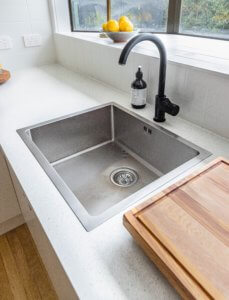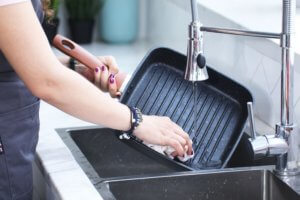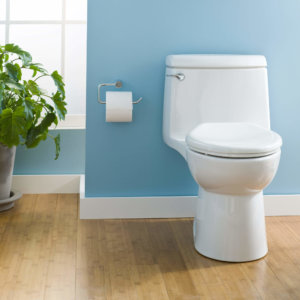5 Tips for Disinfecting the Sinks in Your Home
The sinks in your home get put through their paces every day. To keep them functioning at their best, make sure they are safe for everyone in your household to use. Learn several strategies for disinfecting your sinks.
1. Dedicate Yourself to Daily Bathroom Sink Cleaning

Image via Unsplash by zacgudakov
Just like bathtubs, bathroom sinks require regular, gentle cleaning and disinfecting. To keep your bathroom sink in good condition, you’ll need to clean it daily with mild dishwashing liquid, warm water, and a soft cloth.
If you have a stone bathroom sink, use a pH-neutral cleaning agent formulated specifically for stone surfaces. This regular cleaning and disinfecting routine will keep your sink looking its best and ensure it is clean for family and guests.
2. Tackle Unsightly Soap Scum Buildup in Bathroom Sinks
Once a week, or as necessary, gently scrub bathroom sinks with a mild abrasive cleanser and a soft cloth.
Soap scum, the hazy film that can form on a sink’s surface, can also be a problem. To remove this unsightly layer of residue, which forms when calcium and other minerals in hard water combine with soap, you’ll want to use a slightly acidic household cleaner. White vinegar or a commercial descaling product containing phosphoric acid, such as Lime-Away, can cut through stubborn soap scum and disinfect your sink simultaneously.
Always wear rubber gloves when working with acidic cleansers and rinse surfaces completely afterward. When left on surfaces for too long, acidic cleansers can damage sink surfaces (particularly porcelain surfaces), corrode fittings (the plumbing industry term for faucets), and etch the glaze on tile. Never use acidic products on limestone or marble.
As a general rule, don’t scrub any sink with scouring powder that contains ammonia, chlorine bleach, or hydrochloric acid. Never use steel wool, stiff brushes, or abrasive pads unless directed by the sink’s manufacturer. These products will damage the sink’s surface.
3. Go Mild With Cleaning Agents for the Kitchen Sink

Image via Unsplash by inkyhills
The kitchen sink requires daily gentle cleaning and disinfecting. For routine care, wipe the sink with mild dishwashing liquid, a soft cloth, and warm water.
Don’t scrub any kitchen sink with a scouring pad containing ammonia, chlorine bleach, or hydrofluoric acid. Never use steel wool, abrasive pads, or stiff brushes unless directed by the sink’s manufacturer.
For deep cleaning, wipe the sink with a mild abrasive cleanser, such as Bon Ami, and a soft cloth.
4. Keep Your Kitchen Sink Drain Clean

Image via Unsplash by cookerking
To keep the kitchen sink drain running freely and staying clean, flush it with boiling water once a week. Boil one gallon of water, pour half the water down the drain, wait a few minutes, and pour in the rest of the water. Twice a year, you’ll want to flush drains with baking soda and vinegar (see directions below).
To keep drains clear and safe from bacteria buildup, follow this important rule: Never pour grease down the drain. Animal fats cause the fats in soap to congeal and harden, leading to clogs in the drain. Pour cooking fats and grease into a disposable container, milk carton, or metal container. Once the grease solidifies, discard the container in the trash.
To prevent clogged drains in the first place, use a cloth to remove grease from pots and pans before you wash them. Always keep the strainer basket in the drain free from any food particles or other obstructions. Fine mesh drain screens, sold in home improvement centers, hardware stores, and plumbing supply stores, can trap more matter than traditional drain baskets and are available in several sizes.
5. Treat Clogged Kitchen Sink Drains the Eco-Friendly Way
When you’re faced with a clogged kitchen drain, your first course of action may be to reach for a liquid drain opener. However, these products often contain harmful chemicals. You can take several ecologically friendly steps to unclog the drain and disinfect your sink in the process.
-
Pull out and clean the drain’s stopper. If necessary, use a regular plumber’s plunger to tackle the clog. Place the plunger’s cup into the drain and plunge vertically to keep the water from spraying out of the plunger’s sides. Be sure your plunger has a tight seal against the drain opening. If your kitchen sink has an overflow hole, insert a cloth or towel into the hole. Loosening the blockage may take some time, so don’t give up if you don’t achieve results immediately. If the clog has occurred in a double-bowl kitchen sink, plug one drain with a wet towel and hold it down securely while you plunge the other drain.
-
If plunging doesn’t clear the clog, you can try adding a solution you can make with basic kitchen materials. Pour 1/2 cup baking soda down the drain. Add 1/2 cup distilled white vinegar to the drain, then cover the drain and the sink’s overflow hole with a drain plug or a wet towel. Let this mixture sit for about 10 minutes. The vinegar and baking soda will work together to attack congealed matter and convert it into a salt-like material. Flush the drain with hot water. Using a teakettle is essential because you can safely pour the water down the drain without scalding yourself.
-
You can try enzymatic drain openers that dissolve clogs safely. One product, Super Digest-It, contains freeze-dried blocks of natural bacillus bacteria. These bacteria literally eat the material that’s interfering with your drain, converting solids caught in the drain into water and carbon dioxide.
-
If plunging and natural drain-opening methods aren’t successful, use a drain auger, available at home-supply and hardware stores. Insert the tool into the drain and twist the auger back and forth as you snake it down the drain. When you sense that the coiled auger has reached the blockage, firmly push the auger through the buildup in the drain. Pull the auger back and forth to dislodge the blockage and open the hole. When the blockage is broken up, try plunging the drain. Run water down the drain for several minutes to flush away any remaining bits of matter.
A regular sink cleaning and disinfecting regimen will ensure that the sinks in your home remain in top condition for years to come. If you’re looking for a new bathroom or kitchen sink, contact us at Allied Plumbing & Heating Supply Co. Explore our selection of sinks from trusted name brands offering high-quality products.

